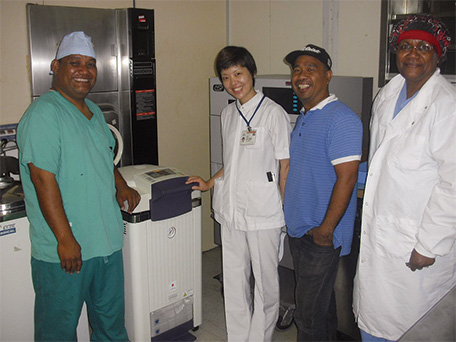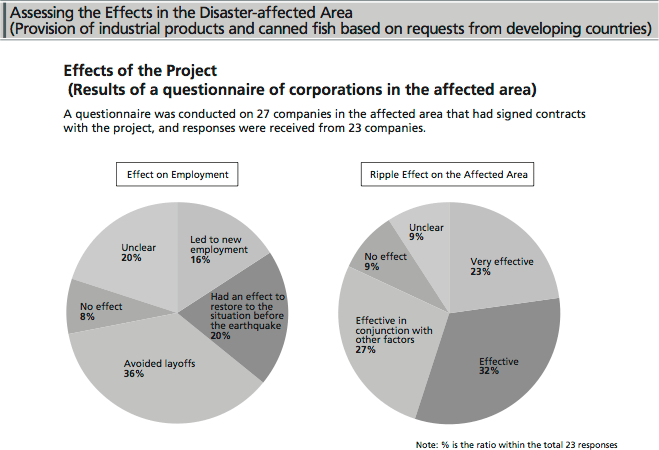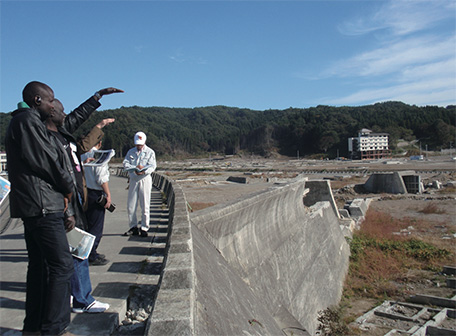Japan's Official Development Assistance White Paper 2012
Section 3 Earthquake Disaster Reconstruction and ODA
While the recovery and reconstruction of the disaster stricken areas of the Great East Japan Earthquake is still in process, many corporations such as small and medium enterprises (SMEs) are restarting operations, and employment is beginning to recover. In order to assist such efforts in the affected areas through ODA, the industrial products made in the affected areas are provided to developing countries, which assist their economic and social development while simultaneously driving forward efforts that contribute to economic recovery in the disaster stricken areas.
Under the third supplementary budget of FY2011, Japan provided industrial products from the disaster stricken areas to 15 developing countries (equivalent to ¥4 billion), and also provided canned fish (equivalent to ¥1 billion) produced in the disaster stricken areas to 5 developing countries through the World Food Programme (WFP). Based on requests from developing countries, these industrial products are procured by tender, which consist of the construction equipment, medical instruments and welfare devices produced in the affected areas of the Great East Japan Earthquake. For example, Japan provided medical and welfare equipment (e.g. endoscopes, x-ray equipment and wheelchairs), etc. manufactured in Iwate, Fukushima and Miyagi Prefectures to developing countries.
After the Great East Japan Earthquake and the incident at the Tokyo Electric Power Company's Fukushima Daiichi Nuclear Power Plant, enterprises in the affected area were forced to cease operations for a long period and were subjected to harmful rumors such as inquiries as to "whether products are radioactively contaminated." Over 70% of contract corporations evaluated that the ODA projects had positive effects on the employment such as providing new employment and avoiding layoffs. Likewise, over 80% of contract corporations evaluated that the ODA projects also had a ripple effect on the local economy (See the diagram).
Similarly, the medical personnel of Marshall who were provided with autoclaves manufactured in Fukushima Prefecture under this project highly praised the efficiency of the equipment and appreciated saying "We can improve hygiene at the Marshall medical institutions thanks to the autoclaves," "The equipment has a larger capacity of sterilization and is very efficient," and "The digital buttons are easy to use."
In FY2012, with a view to also contributing to economic recovery in the areas stricken by the Great East Japan Earthquake, Japan continued to assist developing countries utilizing industrial products made in the affected areas of the disaster.
As well as providing industrial products from the disaster-affected areas to developing countries, trainees from developing countries are invited to Japan for short term training seminars such as the "Seminar on Reconstruction of Damaged Irrigation and Water Management Facilities for Agriculture," and the "Seminar on Disaster Risk Reduction and Infrastructural Restoration." All kinds of existing training lectures are given on the current state of Japan's recovery and visits to the affected areas are arranged, which leads to the correct information being transmitted to the world and was a part of countering rumors. In the future, while continuing efforts to transmit information about Japan's recovery through means such as training, and fully taking the situation on the ground into account, the acceptance of trainees from overseas to the disaster-affected areas will be promoted.
Through those measures, assistance for the industries in the affected areas and contributions to recovery in those areas will be pushed forward.

An installed autoclave and hospital staff at Majuro Hospital on the Marshall Islands. (Photo: Embassy of Japan in Marshall)


Trainees from Africa observing the disaster-affected area of Taro District, Miyako City. (Photo: JICA)
